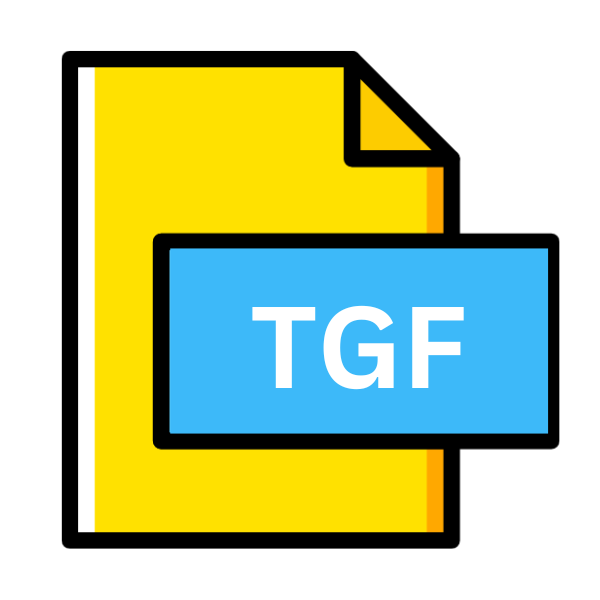.TGF File Extension

Trivial Graph Format File
| Developer | N/A |
| Popularity | |
| Category | Data Files |
| Format | .TGF |
| Cross Platform | Update Soon |
What is an TGF file?
In the vast digital landscape of file extensions, each serves a unique purpose, often tailored to specific applications or systems.
Among these, the .TGF file extension stands out as a format designed for representing graphs straightforwardly and efficiently.
Known as the Trivial Graph Format file, .TGF files provide a standardized way to encode graph data, making them invaluable in various domains, from network analysis to social network modeling.
More Information.
The history of the .TGF file extension dates back to the late 20th century when the need for a standardized format for graph data became apparent.
Initially conceived as a simple yet versatile format, .TGF files aimed to provide a lightweight solution for storing graph structures.
The format gained traction among researchers, programmers, and analysts due to its ease of use and compatibility with various platforms and tools.
Origin Of This File.
The .TGF file extension traces its origins back to the realm of graph theory and computational science. Developed to simplify the representation of graphs, .TGF files emerged as a solution to the complexities inherent in storing and sharing graph data.
Graphs, consisting of nodes and edges, are fundamental structures used to model relationships between entities, making them essential in fields such as social network analysis, computer networking, and data visualization.
File Structure Technical Specification.
.TGF files adhere to a straightforward structure, consisting of two main sections: node definitions and edge definitions. In the node definitions section, each line represents a node, with a unique identifier followed by optional metadata.
The edge definitions section lists the connections between nodes, specifying the source and destination nodes for each edge.
The technical specifications of .TGF files are relatively simple, making them easy to parse and manipulate programmatically.
This simplicity facilitates interoperability between different applications and programming languages, allowing for seamless integration into existing workflows and systems.
How to Convert the File?
Converting .TGF files to other formats or vice versa can be accomplished using various tools and methods. Some common conversion techniques include:
- Using Graph Analysis Software: Many graph analysis software packages support importing and exporting .TGF files, allowing users to convert them to formats such as GraphML, GML, or CSV.
- Custom Scripts: Writing custom scripts or programs to parse .TGF files and converting them to other formats is another option, particularly for users with specific requirements or preferences.
- Online Converters: Several online converters exist that can convert .TGF files to other formats, providing a convenient solution for users who prefer web-based tools.
Advantages And Disadvantages.
Advantage:
- Simplicity: .TGF files have a straightforward structure, making them easy to create, read, and modify manually or programmatically.
- Versatility: .TGF files can represent a wide range of graphs, from simple networks to complex hierarchical structures, making them suitable for various applications.
- Compatibility: .TGF files are supported by many graph analysis tools and libraries, ensuring compatibility across different platforms and environments.
Disadvantage:
- Limited Expressiveness: While .TGF files are suitable for basic graph representations, they may not adequately capture certain graph properties or attributes.
- Scalability: For large-scale graph data, .TGF files may become cumbersome to manage and process efficiently due to their text-based format.
How to Open TGF?
Open In Windows
- Use graph analysis software such as Gephi or Cytoscape, both of which support .TGF files natively.
- Alternatively, use a text editor such as Notepad or Visual Studio Code to view and edit .TGF files.
Open In Linux
- Most graph analysis tools available for Linux, such as NetworkX or Graph-tool, support .TGF files.
- Use a text editor like Vim or Nano to open and modify .TGF files directly from the command line.
Open In MAC
- Graph analysis software like Cytoscape or Gephi, which are compatible with macOS, can open .TGF files seamlessly.
- Utilize a text editor such as TextEdit or Sublime Text to view and edit .TGF files on macOS.
Open In Android
- Install a graph analysis app from the Google Play Store, such as Grapher or Graph Editor, which support .TGF files.
- Use a file manager app to navigate to the .TGF file and open it with a text editor or compatible graph analysis app.
Open In IOS
- Look for graph analysis apps on the App Store that support .TGF files, such as GraphSketcher or Network Analyzer.
- Access the .TGF file using a file management app and open it with a compatible graph analysis tool or text editor.
Open in Others
- For other platforms or devices, consider using web-based graph analysis tools that support .TGF files.
- Another way is to install third-party apps that offer compatibility with the format.













